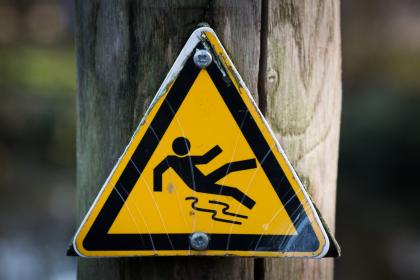
Have you ever wondered why it’s harder to buy a loaf of bread online than it is to buy a car online? Grocery stores make lots of money on impulse purchases based on foot traffic, such as “this looks good” and “that’s on sale.” It’s much easier to resist these impulses when buying online. So, grocery stores continue to encourage as much foot traffic as possible.
Foot traffic is a liability issue for stores. As outlined below, grocery stores are usually responsible for inside and outside safety. Slip-and-falls are the most common grocery store customer and employee injury. Supermarkets spend about $450 million a year to resolve these claims.
Falls usually cause serious injuries, like broken bones and head injuries, which are often permanent. Injuries are especially serious if the victim had a pre-existing condition. Usually, insurance companies cannot use these conditions as an excuse to reduce or deny compensation.
This compensation usually includes money for economic losses, such as medical bills, and noneconomic losses, such as pain and suffering. To obtain these damages, a New York personal injury attorney must build a prima facie (preliminary) negligence case that’s solid enough to survive some common insurance company defenses.
General Principles
Landowners, including grocery store owners, have a legal duty to make these buildings, and the property that surrounds them, reasonably safe.
Fall injury cases, like most other injury cases, start with a duty of care. This duty usually depends on the relationship between the victim and landowner, as follows:
Additionally, the owner must have actual or constructive knowledge (should have known) about the fall-causing hazard. Common indoor hazards include wet spots on floors and items that fall off a shelf. Common outdoor fall hazards include ice patches, which are still common even in spring, and uneven sidewalks.
Victims may use direct or circumstantial evidence to prove knowledge. Smoking guns include prior falls due to a specific hazard and “cleanup on aisle fifteen” announcements. Circumstantial evidence usually hinges on the time-notice rule. As time passes, the possibility of legal notice increases. Store workers don’t have to pick up banana peels before they hit the floor. But sooner or later, and sooner rather than later, the hazard must be addressed.
These same principles apply to other kidneys of premises liability injuries, such as assaults related to inadequate security.
Responsibility Issues
As mentioned, grocery store owners are responsible for all grocery store safety issues. However, it’s not always easy to determine ownership. The last time we looked, we didn’t see Mr. Walmart listed in the phone book.
Some grocery stores, mostly bodegas, are mom and pop operations. But these owners often change the legal names of their establishments. What starts as Mom and Pop, Inc. might become Mom & Pop, LLC, and then M&P, LLC, and then, well, you get the idea. If a New York personal injury attorney doesn’t use the correct name, the victim could end up with a judgment against an entity that doesn’t exist.
Out-of-state holding companies usually own larger grocery stores. These entities don’t need to hide from anyone. Instead, they count on armies of lawyers to protect their interests. As a result, a courtroom battle is often like David vs. Goliath. Most of us know how that story ended. Teenage David killed the giant Goliath, mostly because David had right on his side.
Specific responsibility could come into play as well. The name on the top of the marquee could be incorrect, for premises liability purposes.
Many large grocery stores don’t have exclusive control over the entire store. If you’ve been to Sam’s on a weekend, you know what we mean. Vendors offer free samples on practically every other aisle. These vendors might or might not be Sam’s employees. Additionally, most of these stores include sub-retailers, like small restaurants and nail salons.
These same principles apply to the outside of a grocery store. Usually, stores are responsible for the common areas adjacent to their doors. Another company, like a management company, must maintain all other common areas. Once again, an early misstep could mean a meaningless judgment.
Possible Insurance Company Defenses
Building a claim is step one and identifying the responsible entity is step two. Responding to insurance company defenses, like assumption of the risk and comparative fault, is step three.
If the floor is wet, the owner often puts a “Caution Wet Floor” sign near the spill. If a sidewalk is cracked, the owner might use an orange traffic cone or other obstacle to warn people of the hazard. These signs don’t protect owners from liability. But they do make the assumption of the risk defense easier to prove in court. The elements of this defense are:
If there’s a sign, the insurance company must prove the victim could see the sign, could read it, and could understand what it means. If the victim is very young, very old, or doesn’t speak English well, these elements are difficult to prove, sign or no sign.
In fall cases, contributory negligence shifts blame for an injury from the owner who negligently allowed a hazard to the victim who didn watch where s/he was going. The insurance company has the burden of proof to show the victim was distracted. Absent some outside evidence, like a device use log which shows the victim was using a phone at the time, this defense is pretty hard to prove as well.
Injury victims are often entitled to substantial compensation. For a free consultation with an experienced personal injury lawyer in New York, contact the Pianko Law Group, PLLC. Attorneys can connect victims with doctors, even if they have no money or insurance.